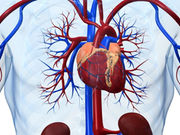HbA1c, HOMA-IR linked to progression of carotid femoral pulse wave velocity in adults
TUESDAY, Feb. 7, 2017 (HealthDay News) — For individuals without diabetes, glycated hemoglobin (HbA1c) is associated with accelerated progression of aortic stiffness, according to a study published online Jan. 25 in Diabetes Care.
Carmel M. McEniery, Ph.D., from the University of Cambridge in the United Kingdom, and colleagues examined the impact of adverse glucometabolic status on aortic stiffening in 4,386 individuals without diabetes from the Whitehall II Study. Glucometabolic status and other cardiovascular risk factors were assessed at baseline (2008 to 2009). Carotid femoral pulse wave velocity (cfPWV) was assessed at baseline and follow-up (2012 to 2013).
The researchers found that during four years of follow-up there was an increase in cfPWV, from a mean of 8.3 ± 0.03 to 8.98 ± 0.04 m/s. cfPWV at baseline correlated with fasting and two-hour postload glucose, HbA1c, and homeostatic model assessment of insulin resistance (HOMA-IR). After adjustment for physiological confounders and cardiovascular risk factors, HbA1c and HOMA-IR correlated with progression of cfPWV. Greater increases in cfPWV were seen with a one-standard-deviation-higher HbA1c (0.11 m/s per five years) and HOMA-IR (0.09 m/s per five years). The correlation with HOMA-IR but not with HbA1c was weakened after additional adjustment for body mass index.
“These findings suggest that long-term glucometabolic status, even in individuals without diabetes, could be an important target for preventative strategies against vascular aging,” the authors write.
Two authors disclosed financial ties to Novo Nordisk.
Full Text (subscription or payment may be required)
Copyright © 2017 HealthDay. All rights reserved.








